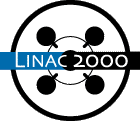
Jean-Pierre Delahaye, Ian Wilson (CERN & Saclay), R. Assmann, F. Becker, R. Bossart, H. Braun, H. Burkhardt, G. Carron, W. Coosemans, R. Corsini, E. D'Amico, S. Doebert, S. Fartoukh, A. Ferrari, G. Geschonke, J.C. Godot, L. Groening, G. Guignard, S. Hutchins, B. Jeanneret, E. Jensen, J. Jowett, T. Kamitani, A. Millich, P. Pearce, F. Perriollat, R. Pittin, R. Potier, A. Riche, L. Rinolfi, T. Risselada, P. Royer, F. Ruggiero, D. Schulte, G. Suberlucq, I. Syratchev, L. Thorndahl, H. Trautner, A. Verdier, W. Wuensch, F. Zhou, F. Zimmermann (CERN), O. Napoly (Saclay)
A high-energy (0.5-5 TeV), high-luminosity (1034 - 1035 cm-2 sec-1) e+e- linear collider is being studied as a possible facility at the energy frontier for the post-LHC era. The beams are accelerated using high-frequency (30 GHz) normal-conducting structures operating at high accelerating fields (150 MV/m) to reduce the length and, in consequence, the cost of the linac. The RF power for these structures is extracted from a low-energy, high-intensity electron beam which runs parallel to the main linacs. This is the so-called 'Two-Beam' scheme. The drive beam is generated in a novel, cost-effective and efficient way. The essential features of the scheme are to use a fully-loaded normal-conducting linac, operating at low frequency (937 MHz), to accelerate one long train of bunches and to split this train into a series of trains using funnelling techniques in combiner rings for beam power compression and frequency multiplication. Each of these trains is then used to provide RF power for a ~625 m section of the linac to accelerate the main beam by 68 GeV. A next generation CLIC Test Facility, CTF3, is being built at CERN to demonstrate the technical feasibility of this drive beam generation and RF power production scheme, albeit on a much smaller scale and at a different frequency.
Comments or Questions to
linac2000@slac.stanford.edu